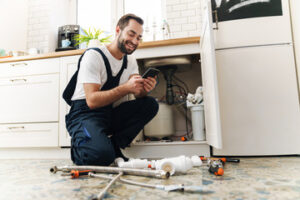Provo UT Plumber installs, repairs, and maintains the piping and fixtures that provide water and sewage to homes and businesses. These professionals have specialized tools and knowledge that allow them to inspect hard-to-reach places in a home’s or business’s plumbing system.

A plumber’s inspection includes tests for water pressure and drain flow rates, as well as checking visible pipes for leaks and signs of deterioration. They also review blueprints and building codes to determine proper installation techniques.
Plumbing inspections are an important part of ensuring your home or commercial building’s plumbing is in good condition. They cover everything from your water heater to your sewer lines. A plumbing inspection can help catch problems before they turn into major (and expensive) issues. A typical plumbing inspection involves a visual examination of all exposed plumbing components as well as the hidden ones beneath floors and behind walls. Some plumbers also use more advanced tools, like video cameras and water pressure testing, to examine hard-to-reach areas of your plumbing.
The first thing a plumber will do in a plumbing inspection is check the drains and traps for any signs of blockages, leaks or damage. They will also test the water pressure to make sure it is within the recommended range. This is important because high water pressure can cause plumbing fixtures to wear out faster, and low water pressure can result in inadequate water flow for cooking and cleaning.
Water heaters are another crucial component of the plumbing system, and a plumber will check both the tank and the heating elements to ensure they are in good working condition. They will also inspect the temperature and pressure relief valves. If you have an older water heater, they may recommend replacing it with a newer model to increase efficiency and prevent future problems like leaks or corrosion.
Plumbers will also inspect your toilets, faucets, shower heads and sinks for any cracks or other damage. They will also check the condition of your water supply hoses and venting systems. Finally, they will examine your washing machine hoses and drain lines to ensure they are secure and not leaking or spraying.
Leaks are a common and often costly plumbing issue, so plumbers will always look for them during a plumbing inspection. They will check underneath and behind all visible components for any signs of water leaking, including looking at ceilings, walls and floors for water stains and mold. They will also check for any unexplained spikes in your water bill that could indicate a leak or clog.
Fixtures Inspection
Plumbing fixtures are a huge part of any home, and they’re used on a daily basis. This means that they need to be working correctly or else you could experience toilet overflows, inexplicable high water bills, and more. A plumber can inspect your fixtures to make sure that they’re in good condition and that nothing is wrong with them.
A plumber can also inspect your piping to make sure that it’s in good condition. Problems with your piping can lead to low water pressure for fixtures, flooding in the basement, or even broken pipes. A plumber can perform a camera inspection of your piping to make sure that it’s clear and free from problems like cracks or damage.
Inspection Fixtures
Inspection fixtures, also known as checking fixtures or gauges, are specialized tools used in manufacturing and quality control processes to verify the dimensional accuracy of parts and components. They are typically custom-designed and manufactured to accurately replicate the geometry and features of the part being inspected, allowing for precise measurements and evaluations.
Most inspection fixtures have mechanisms for securely mounting and clamping the part during inspection. This prevents movement or shifting that might affect the accuracy of the measurements. Additionally, most have datum features or reference surfaces that serve as a point of alignment for the part being inspected. This ensures consistent positioning and orientation of the part within the fixture, resulting in repeatable and reliable measurements.
Conventionally, these fixtures are either machined or constructed from modular kits. However, the stiffness and precision requirements of many inspected parts make machining these fixtures expensive and time-consuming, depleting valuable shop time that could be better spent on revenue-generating activities. Modular inspection kits are less expensive, but they’re difficult to assemble and are not readily swappable.
AMD&E designed a simple, cost-effective, and easy-to-use inspection fixture to allow for the rapid inspection of a radial feature on a aerospace component. The fixture removes the need for a CMM, saving significant time and money in both machine and operator costs. The fixture is also easily swappable between different components, ensuring that the tool is always ready for use and maximizing the number of inspections per hour possible.
Pipe Inspection
Pipe inspections are a vital part of the plumbing process. These inspections help the plumber identify any issues with the pipes, and how to handle them. They also help the plumber prevent future problems and damage. Some of the most common issues include water leaks, clogs, and broken, damaged, or disconnected pipes. Leaking and clogged pipes can cause serious side effects, including a high water bill, rotted foundations, and mold.
Leaks are usually the first sign of a pipe problem, and can be caused by a variety of factors, such as age, root intrusion, improper installation, and poor soil conditions. A plumber can often fix a leak quickly by finding the source and sealing it.
A plumber can use a camera to inspect the condition of your pipes. These cameras are small, flexible, and waterproof, and can give the plumber a clear picture of the pipes’ condition. The plumber can even see any potential problems, like a minor crack, or even a tree root invasion site.
Pipeline inspections are a crucial step in the construction of new buildings and piping systems. They are also a crucial part of renovating old or damaged buildings and piping. The inspections help to ensure that the piping is of good quality and meets all the necessary requirements and codes.
The inspection checklist typically consists of five core criteria: quantity, workmanship, style, color and documentation, and field test and measurement. These inspections are done during the pre-shipment stage when at least 80% of the pipe is finished and ready for shipment.
In addition to checking for dimensional tolerances, the inspector must also check for quality of welds and alignment. This includes assessing the overall weld bead width and height, as well as evaluating surface defects such as porosity or weld spatter. It is also important to note that the pipe must meet the specified material grade and standards.
Depending on the results of the inspection, the plumber may recommend additional tests. These may include positive material identification (PMI), ultrasound testing, and eddy current testing. This information will be used to determine if the pipe is suitable for its intended installation, and to determine if any adjustments are required.
Vent Inspection
Vents carry a lot of your air, so this is an important inspection. They are checked for proper sizing, cleanliness and insulation. Exhaust fans help draw the air through the ventilation system and push it outside, so they need to be working well. Make-up air systems bring in fresh air to replace the sucked out air. This is also inspected for safety and proper operation. Inspectors will also check the ventilation control panels for proper settings and safety features.
This is a requirement of the NFPA 204 Standard on Smoke and Heat Venting. Scheduled annual inspections for smoke vents ensure that they will be ready for fire fighters to use in a fire emergency.

